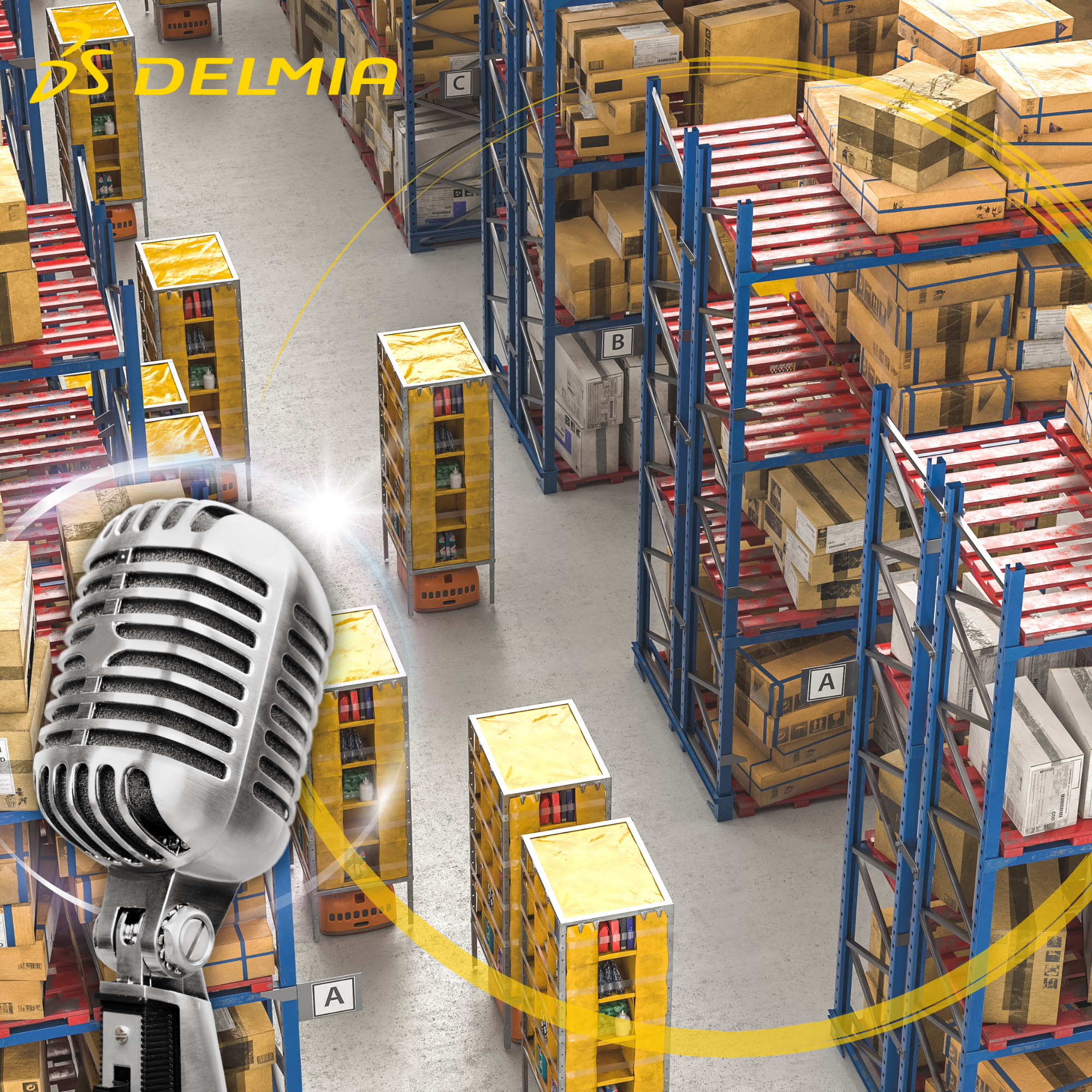
Ep: 38 Build a Disruption-Proof Supply Chain with Network Flow Planner
Hear logistics and supply chain experts Miguel Melgarejo and Olivier Rateau discuss how you can confront delivery and supply chain issues head on.
Tackle Unexpected Events Before They Occur
Picture this: You’re a retailer who manages a supply chain made up of a set of warehouses. You need to transfer goods from your suppliers to the point of sale. Suddenly, one day, there are torrential rains and one of your warehouses becomes unusable by a flood. And then you start asking yourself questions like, “Does my supply chain have enough capacity to manage all the flow of goods with one less warehouse? If so, to which warehouses? Should I attach the points of sales that were linked to the flooded warehouse? There will be capacity issues in some of the processes inside my warehouses, so what is the best strategy to solve those bottlenecks without affecting my service levels?” You might continue with “Should I increase my staff? Should I increase some extra time? Or should I rent a new warehouse?” These questions and more are answered with our discussion on DELMIA’s Network Flow Planner, the virtual twin of the supply chain. Listen in to learn more.
Discover more:

Meet Our Speakers

Miguel Melgarejo
Euro West DELMIA Industry Process Consultant

Olivier Rateau
DELMIA Euro West Sales Expert Senior Specialist
You can follow the DELMIA "Global Operations on the Go" podcast on Apple podcasts, Spotify, YouTube Podcasts, Deezer, by RSS or wherever you get your podcast


![]()


Introducing Network Flow Planner Experts
THERESE: Welcome to our DELMIA podcast, Global Operations on the Go. I'm your host Therese Snow. Today you'll learn about DELMIA’s Network Flow Planner: what it is, what it does and how it can impact your business. Our experts on the topic are Miguel Melgarejo, Euro West DELMIA Industry Process Consultant, and Olivier Rateau, DELMIA Euro Senior Specialists, DELMIA Process and Services. Gentlemen, welcome!
MIGUEL: Welcome. Thank you, Therese for having invited us to this new episode of global operations on the globe. I have to admit that since we were invited, I have heard some of the past episodes and become a fan of the podcast. I heard those ones about next evolution of industrial robotics, another one about scheduling on the cloud. And they found it super interesting. So thank you.
THERESE: That's fabulous to hear. Thank you for sharing.
OLIVIER: Thank you Therese has also for inviting us. We’re very, very glad to be here. I was very lucky to drive this project together with Miguel, but also Laurence. And with the help of Anna, Moshe, Ken, and Mark Carney. We are very happy to be here today. And to give to the audience more information regarding this fantastic product, we designed the network flow planner.
Solving challenges with Network Flow Planner on the Virtual Twin
THERESE: Perfect! You know, it definitely takes a team to pull something like this altogether. And thank you for mentioning them. I am glad that you're both here. To kind of jump in to a little bit on what is DELMIA’s Network Flor Planner. So let's get started. From what I understand, DELMIA Network Flow Planner basically empowers retailers to streamline their warehousing, transportation operations and decision making processes. Let's start with you, Miguel, what would you say that's accurate? Can you expand on that?
MIGUEL: Yes, I think that's a good starting point to understand what network flow planner can do. So DELMIA Network Flow Planner is a Virtual Twin of the Supply Chain that connects all its elements, from suppliers to points of sale, passing through transportation and warehouses. And what is more interesting is that you can manage all the processes that happen around those elements. So let me give you an example. Imagine that you are a retailer that manages a supply chain made up of a set of warehouses, and you need to transfer goods from your suppliers to the point of sale. Suddenly, one day, there are torrential rains and one of your warehouses become usable by a flood. And then you start asking yourself questions like, “Does my supply chain have enough capacity to manage all the flow of goods with one less warehouse? If so, to which warehouses? Should I attach the points of sale that were linked to the flooded warehouse? There will be capacity issues in some of the processes inside my warehouses, like it will be the inbound the storage or the preparation processes, and which is the best strategy to solve those bottlenecks without affecting my service levels, of course, and respecting a financial immersion.
Another question is, should I increase my staff? Should I increase some extra time? Or maybe should I rent a new warehouse? And of course, which is the financial impact of those decisions, and the mental impact as well? How many supplementary tons of co2 I'm going to emit, and which are the costs behind those emissions? So basically, all those questions, among others, are the ones that Network Flow Planner helps you to give an answer.
Timing unplanned events
OLIVIER: Yeah, that's very interesting pitch to introduce the this solution. Thank you, Miguel. I would infer this a few points. If you take France as an example, which is actually quite a large country and a large market for retailers. A typical large retailer in France may have up to 60 warehouses. So, it's a very high number of warehouses spread all over the territory, and more than 5,000 stores to deliver daily. You understand that the different path that the goods may take are infinite. This is why we're talking about the network flow planner. This tool which is as Miguel said, a supply chain twin will allow you to find the proper organization on different timescale could be the proper organization from one year time. So when you are planning making your budget, for instance, calculation could be the best organization for the next four weeks to come when you're trying to adapt timely, your resources and also it could be the end.
Or to some unpredicted events like flooding, like a strike, like whatever may happen, and where it makes sense. Also, for large organizations, which are, it's important to remind people that those retailers, they have very low margin, okay. So they are very, very sensitive to costs. And this tool supply chain twin is really allowing to make savings really, because the it is, feasibility is possible to use the algorithm to make sure that we will first saturate the in-house resources. So all the warehouses that are belonging to the retailer should be the first to receive the goods, and we should make sure that they are 100% staffed. And then the twin may allocate the extra volume to subcontractors, you see. So, this twin is really also a moneymaker. And that's why we believe it has a very large chance to be a success in the future.
Addressing “The Amazon Effect”
THERESE: All right, that sounds great Olivier. So, you basically explained what exactly are some challenges that retailers are facing today. Are there any other challenges that they should be aware of and how network flow planner could help them?
OLIVIER: Sure, this is, I think, a very interesting aspect also of this world project, because supply chain is is really becoming a very important matter. That was not the case in the years before. This moment it is called also the “Amazon effect.” Supply chain is becoming a differentiation axis. So, in case you are providing your customers with the very good logistics, so you are delivering the right product on time and in case something is happening wrong, you have a very nice customer service etc., This is becoming very strong differentiation axis, we may also consider that inflation is very high in logistics. So the cost share of logistic and transportation became much higher than what it was in the past. And also I will say that the big challenge for those large retailers is to remain experts, and to be able to cope with turmoil inside the logistics, like we say strike war and national, I will say whether disaster this kind of stuff. So being competitive now is not possible in case you don't have proper tools to do it. I will say another big challenge is the complexity. Because the trend today is to have smaller shops, and to deliver to those shops, smaller quantities. So in terms of logistics, it makes the puzzle harder to solve. Add on top of that. we are now having more and more low emission zone where you have to enter and exit with electric vehicles, which makes the logistic more complex.
And I will say also that external gross annual restructuring, so is creating also some puzzle that are pretty hard to cope with. And I would end this demonstration about the challenges that we have a lot of seasons. More and more you have this season of the winter season, this season of the Olympic Games, for instance, those seasons are also pretty hard to organize. And the supply chain twin is a fantastic tool to make scenarios, and to find the proper organization prior to the event to happen.
THERESE: Well, that definitely makes a lot of sense. And it's quite clear with the benefits. So very interesting. Absolutely.
THERESE: Now, I'm going to jump over to you, Miguel. Does this optimize retail operations?
MIGUEL: Definitely, definitely. And this is one of its main capabilities or even benefits. So if I have to sum up those benefits, I will say that network flow planner can help retailers to first it gets better visibility. So that's related to the complexity of the supply chain that Olivier was mentioning before. So it helps the retailers to analyze the health of their supply chain and this is not an easy task, right? So that means that they can identify if their supply chain if their capacity issues if there are bottlenecks if there are stock outs on where and when. That's not trivial to identify with this kind of complexity. The second one is improve efficiency. So and that this is here with where we came with our super powerful optimizer. That it helps to a retailer to improve their operation following different strategies based on their main goals. That means their business goals, these are not optimization strategies that the they can pre- configure in the system, that the solution allows the users to configure their own strategies to optimize. So that means prioritize service levels on some financial aspects or reduce co2 emissions and transportation costs or so each user can prioritize those business goals in order to impact and improve the efficiency of the supply chain.
And the third point it will be to improve their margins. So as we have already discussed about that, so network flow planner allows our customers to perform Profit and Loss analysis. And thanks to those simulation scenarios that determine which is the better strategy that managed to improve the company's profit while maintaining their customer service targets. I will say, in general, of course, one of the main goals of the Network Flow Planner is to optimize the supply chain and their operations of the retailers.
Addressing a sudden surge in orders
THERESE: Now that sounds great. So Olivier, let me turn to you again. So what if, for example, a retailer has a sudden surge in orders? Can it be addressed with network flow planner?
OLIVIER: Oh, thank you for this question. I think it's a pretty interesting question, because it's underlying the capacity of our supply chain twin to mimic different logistics schemes. And that is very important point. We were able to design the supply chain twin. In order to make sure that the different tactics in logistics could be put in place. I'm referring to the different transportation plan that a retailer may apply to the goods to go from the supplier to the point of sale. And when you're talking to specialists in logistics, this is exactly what is at stake, you may have the capacity to deliver directly from the supplier to the store or you have the I will say the nominal flows that are going from supplier to pallet storage, then to preparation and shipping. But you may also find strategy that are implying cross docking. Cross docking means that you are not going to store you will just use one warehouse to bundle together different shipments that come from different suppliers and will go to the same point of sale. And our supply chain twin thanks to the optimizer will balance those different Supply Logistics schemes. It will balance the benefits and the cost of those different logistics schemes to find alternatives to a sudden surge in orders. So to answer your question, yes, it is allowing to find on-the-go in real time alternative to a crisis in capacity.
MIGUEL: I want to add one more thing here, Olivier, because I want to tell one more story that we identified in one retailer that we have worked with. So what they what they see is that there is an issue when they are on bank holidays, because all the warehouses are closed at those days, right? And they didn't manage with the current tools to smooth the capacity on the days before in order to have enough resources to monitor all the goods that they have to transport within before those bank days and after those mandates. So network flow planner has native capability that it's the smooth optimization that allows to smooth the load that has to be transported from the suppliers to the points of sale. And with that you don't need to improve or increase your resources in your warehouses. But in addition to that, you can move some resources from one day or from one period to another to smooth those capacity of your warehouse. So that was a really key capability that some retailers were really interested in.
THERESE; Now I can definitely see why I can see where network flow planner does really such an efficient job in balancing demand in orders, given some of the stories that you mentioned. What would you say are some of its key capabilities?
MIGUEL: Yeah, so I think the key capabilities we can summarize it in three main boxes. So the first one is the bottlenecks or allergy identifications and that's related with the disabilities. So monitor the health of your supply chain, right. So that's, that's one of those. The second one is a super powerful optimizer. So you can as we have already discussed, you can create a different optimizer strategies and that's it on business goals. The third one, it will be the simulation scenario so you can create different scenarios based on those business goals and compare them to create a profit and loss analysis and take the better decisions that will help your company to improve your margin or your benefits.
THERESE: Alright, so I know that all sounds great.
THERESE: There's one thing I'm curious about. Will a virtual twin help, for example, a type of supply chain virtual twin?
OLIVIER: Sure, I think that this is a key point, if you want a supply chain twin to be sustainable. Meaning that if you want not to pay for nothing, it is important to understand that we are tackling here is three different horizons:
- the strategical horizon
- the tactical
- and the operational one.
We talked about the operational why quite a bench in this interview Okay. And what is happening in urgent surge? What is happening in case you have a flood or so on? It is important to stress that the tactical layer meaning what is happening in the coming weeks is even more important. The fact that the twin is used on a weekly basis to make adjustment in the capacity meaning the square meters, your organization of the warehouse, the number of people that you staff for reception, preparation and shipment is the most important process. Then thanks to this process, you will sustain I will say more strategical process to calculate your budget for instance, or merger and acquisition project or restructuring or even you can use the twin to calculate the volumes for your tenders and to send the proper tenders and the right segregation of volumes to your subcontractors. And you can also in the other side, use the twin for operational purpose on-the-go when you have to cope with an unpredicted event.
THERESE: You know, this is a really been a very detailed and productive conversation. Olivier and Miguel both it really has been a pleasure speaking with you and hearing about the accomplishments of not workflow planner, what it can do and how it can definitely benefit retailers and other industries. So thank you so much for being guests on the show.
MIGUEL: Thank you.
OLIVIER: Thank you very much, Therese. Thank you for this opportunity, because we have a lot of colleagues that are asking us what the Network Flow Planner can do. So now with podcasts, we can send it to them. So thank you. I absolutely will.
THERESE: So there you go. Now they have a place to listen. So I want to thank our listeners for tuning in. And to learn more about DELMIA network flow planner, click on the link where this podcast is posted. I'm your host Therese Snow and you've been listening to DELMIA’s podcast, Global Operations on the Go!
Keywords
retailers, supply chain, twin, warehouses, miguel, planner, logistics, network, flow, capacity, suppliers, goods, therese, operations, order, optimizer, costs, transportation, strategy, capabilities